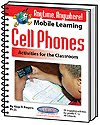Technology should never be the lead actor in the play. It should always be the supporting actor for good instruction. For example, if you are using cell phones in class, don't say to students, “Today we are going to do a cell phone activity”. Instead, you should say, “Today we are going to compare and contrast…”
Here are four critical mistakes that teachers make when integrating technology into instruction.
1. Becoming Masters of Technology. Thinking you have to master the technology before allowing students to use it. You do not have to be an expert with the technology before you allow students to use it (this is often just an excuse not to use the technology). Students will happily assist you.
 2. Being afraid that you will “break” the technology. Sure hardware can be broken if not taken care of properly. However, for the most part it is difficult to break something that is on the Internet—Web 2.0 tools. You are not going to break the technology.
2. Being afraid that you will “break” the technology. Sure hardware can be broken if not taken care of properly. However, for the most part it is difficult to break something that is on the Internet—Web 2.0 tools. You are not going to break the technology. 3. Thinking too big. Every student in your class does not have to do the same thing at the same time. Differentiate. Use small groups. Assign a project that can be completed outside of class. For example, students could be assigned a book report where they use Animoto to create a commercial that summarizes the book. Students can email the final product to you. Another idea is to consider soliciting help from another staff member or parent to help in the computer lab instead of going it alone with 25 students and 25 computers.
4. Not identifying the purpose. Sometimes we use technology for the sake of using technology (bringing the WOW factor into the classroom). The WOW factor does allow educators to leverage novelty to engage students. The problem with this is, many times we miss a real opportunity to develop technology integration pedagogy and teach 21st century skills. For example, if you have students work in groups to produce a Google Doc, I would think the purpose of that activity is not just to have students use a Google Doc to complete an assignment. The purpose should be to have students communicate, collaborate and think critically (three of the four Cs of 21st century skills- communicate, collaborate, create and critically think).


